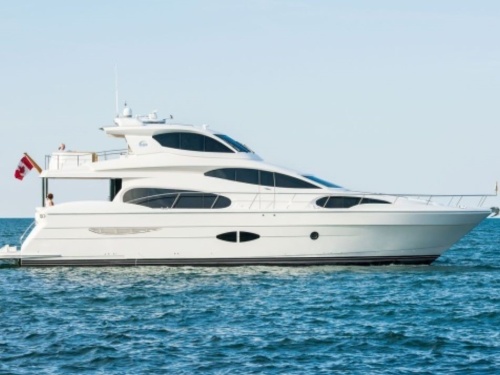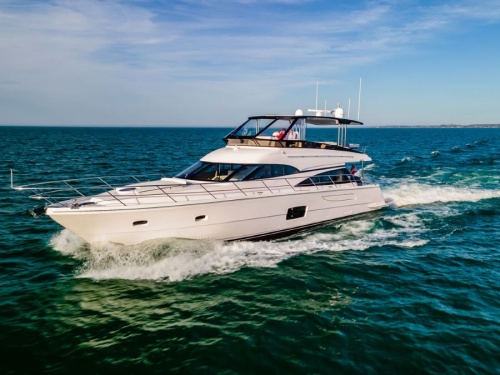Access More Boat Tests
Already have an account? Login
Neptunus 650E (2023-)
2 x 1,136-hp CAT C18
Brief Summary
The Neptunus 650E is a robustly constructed family cruising boat that makes the most of its dimensions to provide features and onboard space. With a pair of upgraded 1,136-hp Caterpillar diesels, her performance allows the operator to choose between speed or range.
Key Features
- Twin 1,136-hp Caterpillar C18 diesels
- Amidships full-beam master stateroom
- 21-kW Caterpillar generator
- Hydraulic swim platform
- Innovative fuel-fill system
- Oil change system
- Comprehensive labeling of systems and safety gear
- Crew’s quarters
Test Results
| RPM | MPH | Knots | GPH | MPG | NMPG | STAT. MILE | NM | dBa |
|---|---|---|---|---|---|---|---|---|
| 625 | 8.2 | 7.1 | 4 | 2 | 1.8 | 2017 | 1754 | 64 |
| 1000 | 11.6 | 10.1 | 14 | 0.8 | 0.7 | 820 | 713.3 | 69 |
| 1250 | 13.7 | 11.9 | 28 | 0.5 | 0.4 | 484 | 421.2 | 69 |
| 1500 | 18 | 15.7 | 44 | 0.4 | 0.4 | 405 | 352.2 | 71 |
| 1750 | 24.2 | 21 | 63.5 | 0.4 | 0.3 | 377 | 328.1 | 73 |
| 2000 | 30.4 | 26.4 | 92.5 | 0.3 | 0.3 | 325 | 282.5 | 77 |
| 2200 | 35.8 | 31.1 | 108 | 0.3 | 0.3 | 328 | 285 | 77 |
| 2330 | 38.5 | 33.5 | 118 | 0.3 | 0.3 | 323 | 280.9 | 81 |
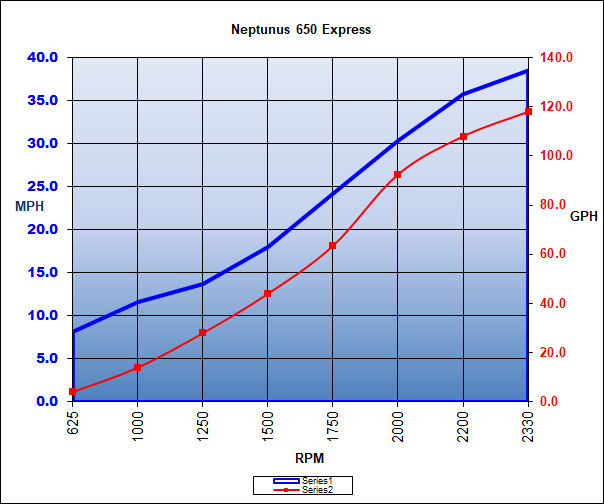
Specifications
| Length Overall |
66' 4" 20.21 m |
|---|---|
| Beam |
16' 7" 5.05 m |
| Dry Weight |
77,000 lbs. 34,927 kg |
| Tested Weight |
81,740 lbs. 37,077 kg |
| Draft |
4' 8" 1.42 m |
| Fuel Capacity |
1,100 gal. 4,164 L |
| Water Capacity |
300 gal. 1,136 kg |
| Total Weight |
81,740 lbs. 37,077 kg |
Acceleration Times & Conditions
| Time to Plane | 7.1 sec. |
|---|---|
| 0 to 30 | 14.9 sec. |
| Props | 31x41 Veem |
| Load | 2 persons, 1/2 fuel, 1/3 water, 50 lbs. of gear |
| Climate | 76 deg., 68 humid; wind: 0-5 mph; seas: 0 |
Engine Options
| Tested Engine |
2 x 1,136-hp CAT C18 |
|---|---|
| Std. Power |
2 x 1,000-hp CAT C18s |
Captain's Report
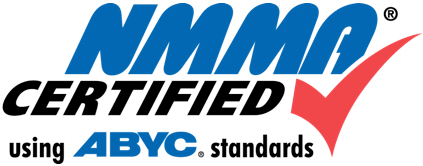 Learn More
Learn More
Watch Our Video
Contents of Report
- Mission
- Getting Underway
- Performance Test
- Handling
- Docking
- Yacht Inspection
- Swim Platform
- Aft Deck
- Salon
- Galley
- Dining Area
- Helm
- Accommodations Deck
- Master Stateroom
- Guest Stateroom
- VIP Stateroom
- Side Decks
- Bow
- Crew's Quarters
- Engine Room
- Construction
- Observations
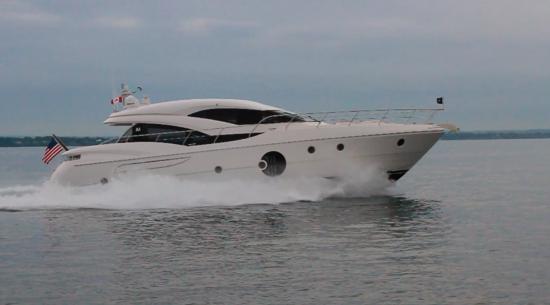
Mission
The Neptunus 650 E is a family cruising boat that is robustly built to handle rough conditions – after all, she’s CE certified to Category A – Ocean, according to the builder. She has a spacious layout and good headroom on the lower deck, including in the engine room, which translates to a yacht that will be comfortable to live on and run for extended periods. While rated for offshore cruising, her range would suggest that this yacht is a cruiser built for longer coastal excursions.
She is intended for an owner/operator.
Getting Underway
As we prepared to get underway, we put the thrusters into “hold” mode, to add a bit of pressure to keep us at the dock. In that way, a single-handed operator can leave the helm to handle the lines and cast off. Once the lines were clear, we stopped the thrusters from holding the boat against the dock and used them to push us away from it.
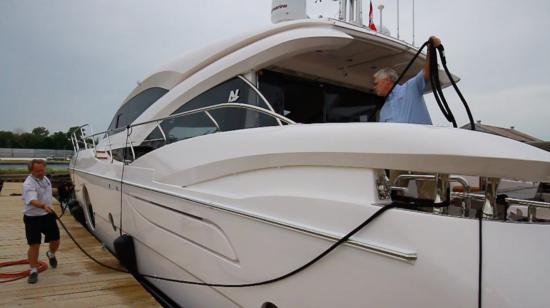
Performance Test
The Neptunus 650E has an LOA of 66’4” (20.22 m), a beam of 16’7” (5.05 m), and a draft of 4’8” (1.42 m). With an empty weight of 77,000 lbs. (34,927 kg), 54% fuel, 30% water, and two people onboard, we had an estimated test weight of 81,740 lbs. (37,077 kg).
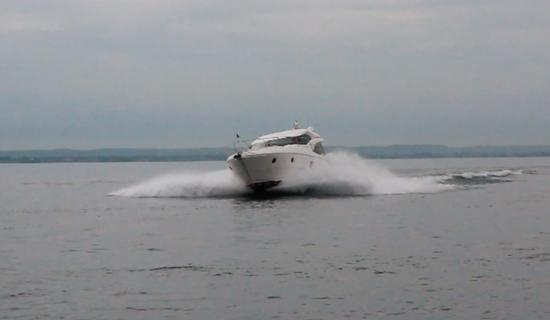
WOT Speed. With the twin 1,136-hp Caterpillar C18s turning 31 x 41 Veem propellers through a 1.97:1 reduction, we reached our top speed of 33.5 knots at 2330 rpm. Cruise performance is fairly linear, meaning the slower the boat goes, the farther she can go.
At the CAT-recommended cruise setting of 80% load, we were at 2000 rpm and 26.4 knots. At that speed, the 92.5 gph fuel burn translated into a range of 282.5 nautical miles. Drop her down to a 10-knot displacement speed and the range opens up to over 713 miles. All of course while still holding back a 10% reserve of the boat’s 1,100-gallon (4,163.8 L) total fuel capacity.
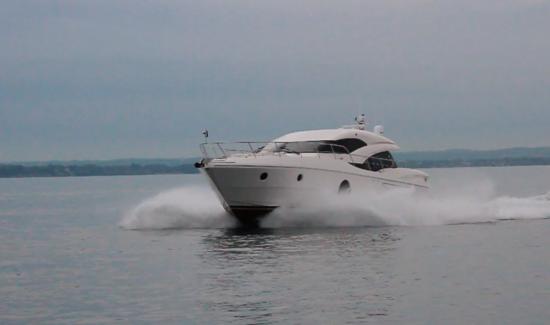
The Neptunus 650 E can top 33 knots, but slowing down will greatly extend range.
Handling
The handling characteristics of the 650 E are much like a typical motoryacht. Nothing happens fast, nor should it. Everything is graceful and comfortable and the more I drove her the more I liked her. She has sporty handling and is very responsive to the helm.
In turns, she rolls an easy 7 degrees into the turn and notice how she drops her shoulder into the turn. This normally causes a lot of drag but we only lost 2 knots. And even with all of this responsiveness, she never gets uncomfortable for even the most land-based guests onboard. Of course, we had flat-calm conditions on Lake Ontario, so we can make no comments on the rough-weather handling of this boat, but she slices convincingly through the wake of our camera boat for what that’s worth.
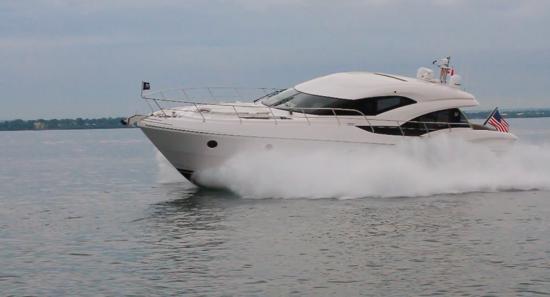
In turns at speed, the Neptunus 650 E had a reassuring inward lean.
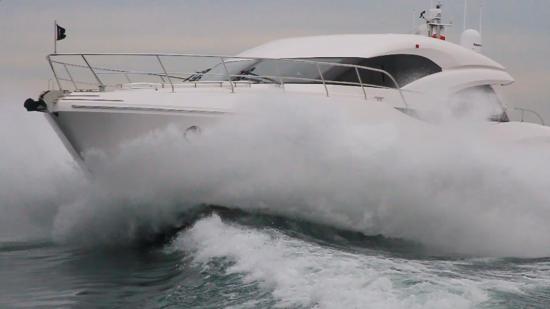
The Neptunus 650 E has a chine that carries far forward, throwing any spray from our camera-boat wake far to the side.
Acceleration
Putting the throttles to the pins had her reaching planing speed in just over 7 seconds and 20 arrives just after that. 30 mph will take nearly 15 seconds.
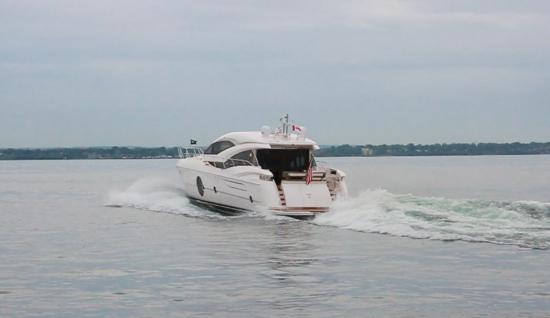
The Neptunus 650 E maintained a level running attitude while accelerating.
Docking
Without any practice, and with a 3-knot current in the canal, he wanted to maneuver the 650 E through this narrow basin entry, where solid bulkheads sit to either side. There’s some risk involved if the controller loses connectivity.
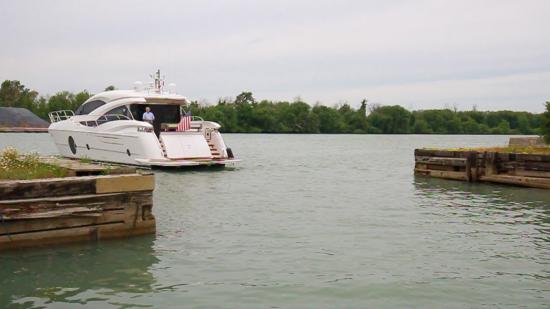
Standing on the aft deck, our test captain turned the Neptunus 650 E and let the current take the boat until it was lined up with the entry.
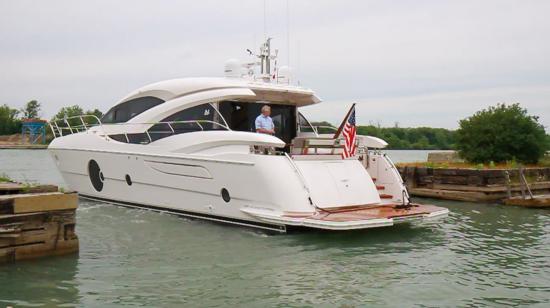
He backed her down while at the same time using the thrusters to work against the current…
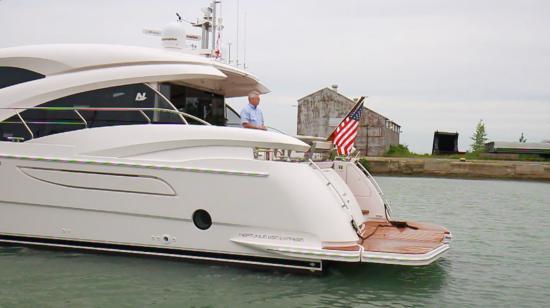
…And it worked without a hitch.
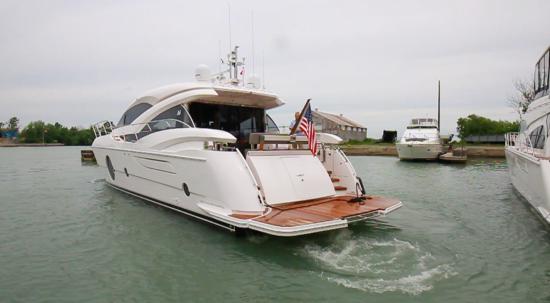
Once in the basin, Captain Steve rotated the Neptunus 650 E 180 degrees around and laid her up, starboard side, nice and gently. Note the mains and thrusters working together, all from a wireless remote on the aft deck.
Yacht Inspection
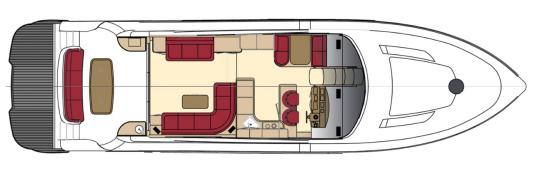
With a spacious salon aft and a galley and dinette handy to the helm, the operator should be surrounded by family and friends.
Swim Platform
We’ll start our inspection of the Neptunus 650 E at the swim platform. It’s hydraulic, is standard, and designed to accommodate a 14’ (4.27 m) Nouvarania tender. Neptunus will add removable cradles to the planks and popup cleats in the platform quarters with which to tie up the painter when the tender is launched.
That design ensures that there is a 14” (35.56 cm) space between the dinghy and the transom door so it still opens with the dinghy in place, thanks to pantograph hinges. The platform’s center section measures 5’7” (1.70 m) from the transom. A grabrail extends 4” (10.16 cm) beyond that in the center. Swimmers will find this welcome.
Normally with yachts in this class, we see 3/8” (0.95 cm) or even ¼” (0.64 cm) thick teak on the platforms, but here it’s ½” (1.27 cm). Even better, that teak extends to the fixed platform section all the way to either side, welcoming guests with its sun-warmed softness as they board. The larger mooring cleats are mounted to the bulwarks, out of the trip zone, and they blend in with the grabrails.
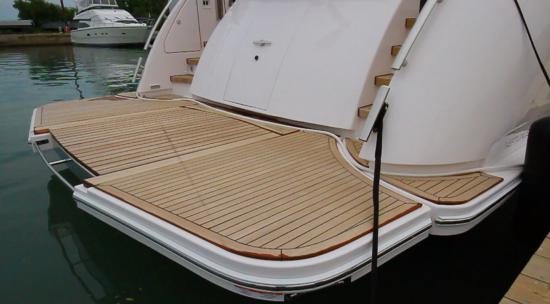
The swim platform is the proverbial teak beach and it extends more than 5’ (1.52 m) aft…
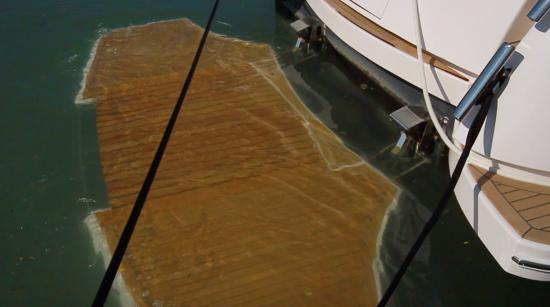
…And it’s hydraulic so it submerges to launch the tender. We’d like to see steps or a ladder from at least one set of the cockpit stairs to add utility.
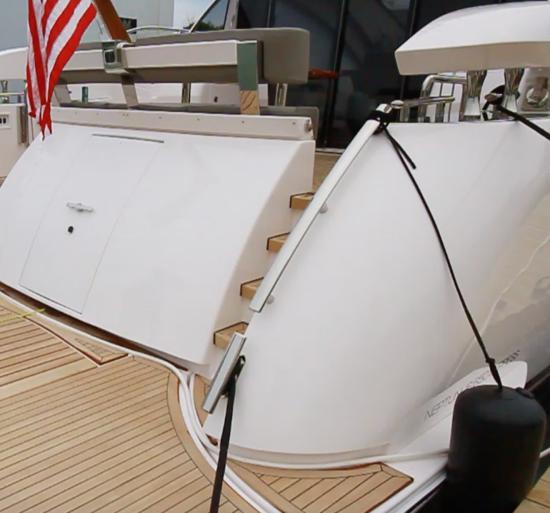
The railing on the bulwarks protects passengers and crew climbing the aft stairs to the aft deck, and the cleat at the lower end is well-designed to blend in.
Cockpit Stairs
The teak on the cockpit stairs along with that on the aft deck comes in a Trim Package option ($32,500), which also includes an extra coat of anti-fouling bottom paint and black netting windshield covers. We’d like to see the teak stairs as standard, as there is nothing more slippery than wet fiberglass stairs. Of course, there is nothing quite like a teak aft deck, and with the teak swim platform, it goes together.
Switches at the top of the steps are recessed into the bulwarks so they aren’t activated by bumping into them. On the port side, they operate the standard Glendinning Cablemaster shorepower cord reel and swim platform. To starboard, they control the cord reel and courtesy lights.
There are lockers in the bulwarks with carbon-fiber doors and gasketed frames. At the top are stainless frame gates that drop into locked positions when opened or closed.
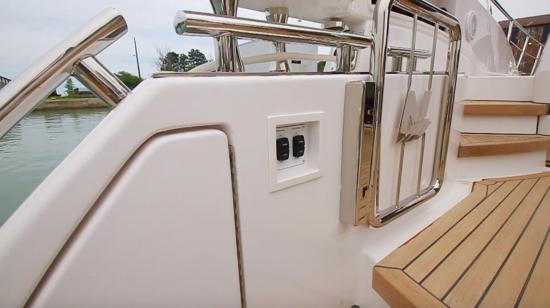
Note the rounded door edging and soft radius moldings. Recessed switches outside the transom gate are handy.
A Note on the Shore Power System. Both sides have a 50-Amp shore power cord just forward of the line handling gear. One of these is dedicated to the air conditioner, but there’s a switch in the crew space that combines everything into one line.
Aft Deck
For line handling, bulwarks to port and starboard of the cockpit have a 14” (35.56 cm) cleat mounted to polished stainless steel. A hawsehole leads to stowage for the excess line. Just ahead is space for an optional warping winch – which certainly isn’t needed with the standard bow thruster.
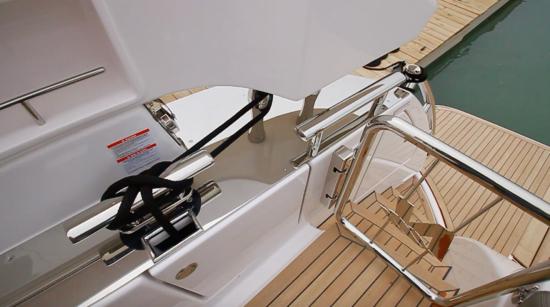
The cleat is designed to coordinate with the handrail aft.
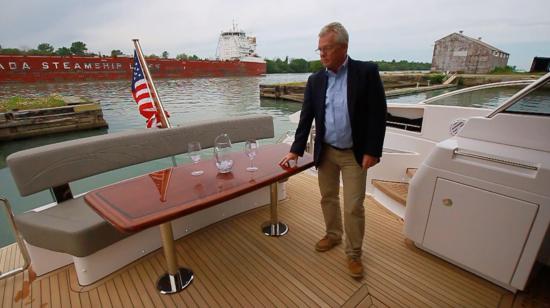
An aft bench seat across from the transom has finely stitched all-weather upholstery behind a finished table on two pedestals.
The 7’3” (2.21 m) aft-deck overhead protects only part of the deck but a retractable awning can be extended at the push of a button. On either side of the glass-and-stainless bulkhead to the salon are consoles, containing a grilling station to port, and a sink and prep area to starboard. There’s a fresh water washdown just alongside. A foldable ladder allows access to the overhead for servicing the antennas, or to lower them to pass beneath the bridge, and it stows conveniently in the crew’s quarters.
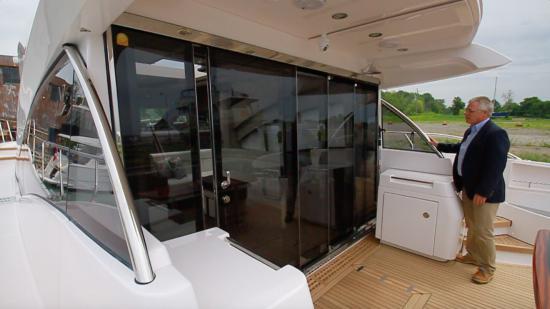
The sides of the aft deck are protected from stainless framed-glass fashion plates that blend into the side windows.
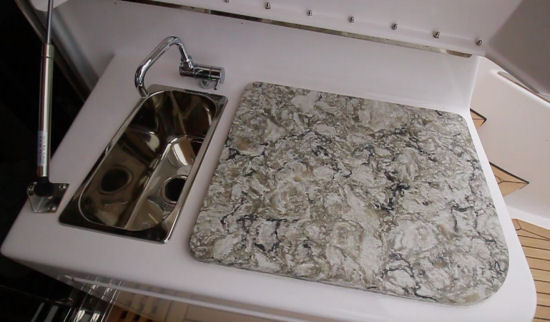
The sink is to starboard with a cutting board.
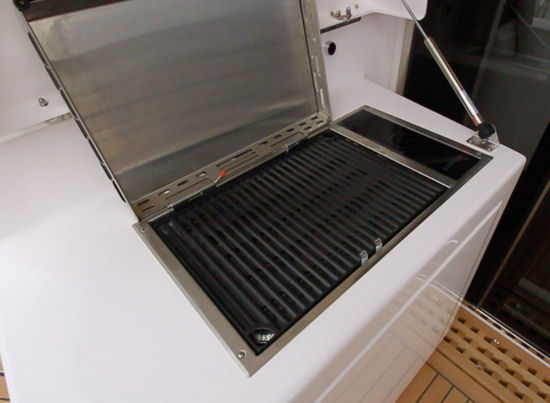
The grill is to port, under a lid held up by a stainless steel gas-assist strut.
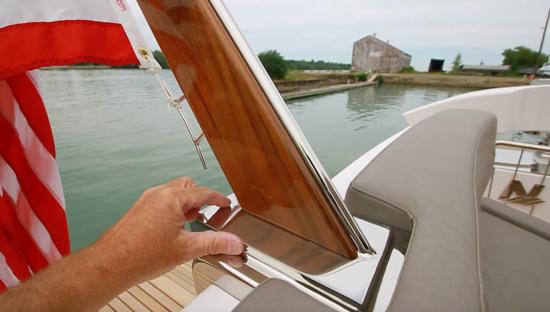
The flagstaff shows off how Neptunus fabricates polished stainless steel in-house, with a varnished teak staff.
Salon
Entering the salon, our test captain noticed that there’s no step. Instead a teak grate in the deck abaft the threshold keeps water from the aft deck from entering the salon. The first impression of this area is one of a yacht-like feel. Somehow, Neptunus manages to maintain a sleek, express cruiser profile while providing a 7’8” (2.38 m) overhead height.
This is one of the highest overheads we have seen in class and it adds to the grandeur of the vessel. This airy feel is magnified by the massive side windows, and the opening skylight, which all combine to enhance the bright, open space.
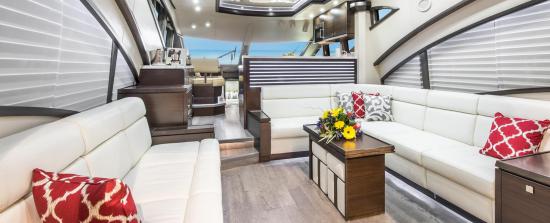
This image is of another 650 which had a sofa to port. The sole is wide-planked engineered hardwood from bulkhead to bulkhead – all standard.
On our test boat, seating to port consisted of a pair of easy chairs upholstered in white leather, flanking an end table to port, opposite an L-shaped sofa with a coffee table and another end table at the aft end. As can be seen in the pictures on this page, owners can opt for a sofa to port instead of the individual chairs. Either comes standard.
There’s convenient stowage inside the coffee table, and in pull-out drawers, as well as under the armrests and seats. The fit-and-finish is exemplary with cherry wood trim on the overhead and side bulkheads, all with horizontal grain and satin finish, and dimmable LED lights throughout. The two 6” (15.24 cm) steps forward to the galley have mirrored risers, which is a good idea.
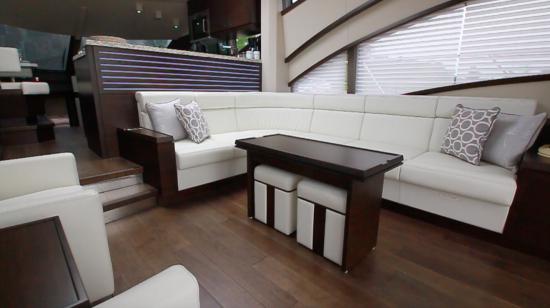
The coffee table has pull-out ottomans that also have stowage.
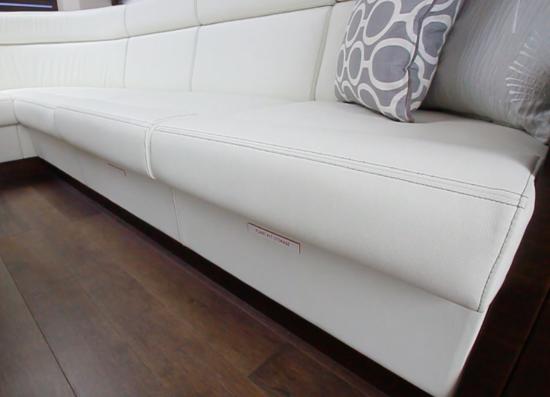
There’s dedicated, labeled stowage for safety equipment in the salon. That label reads “Flare Kit Storage.”
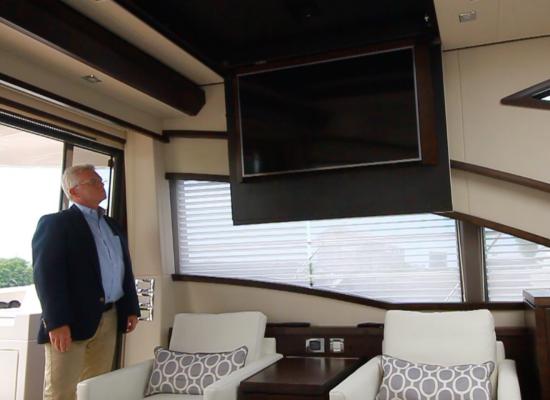
A 49” (124.46 cm) TV folds down from a flush hatch in the overhead at the touch of a button. All entertainment electronics on the boat are optional.
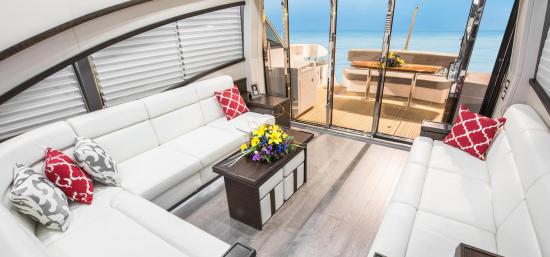
This is another version of the boat's salon with a sofa to port instead of chairs.
Galley
Neptunus-built joinery continues forward with a glass-faced stemware holder just over the entertainment center. Quartz counters serve as a prep area atop the portside cabinet. Stowage includes a wine chiller. The galley proper features more of the quartz counters, and four refrigerated or freezer drawers in any combination desired, and have easy-to-use latches and they’re all soft close.
The galley features a corner-mounted stainless steel sink with a simple rail to create stowage just behind. Additional stowage is in a cabinet above. There’s a convection microwave, an induction cooktop with removable rail and a vent fan as well as an opening side window. A convection oven is below, with locking pins and a dishwasher.
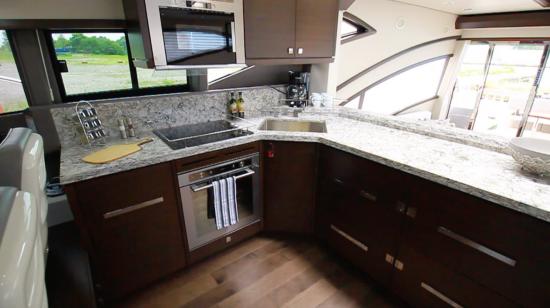
The galley has undercounter refrigeration to preserve lines of sight aft. Note the opening side window to the left of the stovetop.
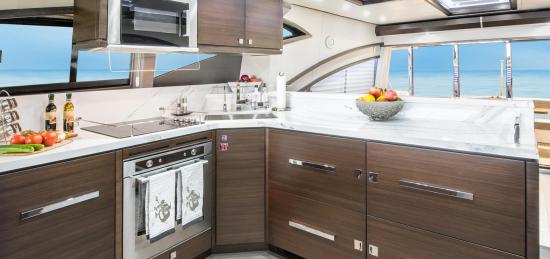
A brighter version of the L-shaped galley allows two or even three people to work in it at the same time.
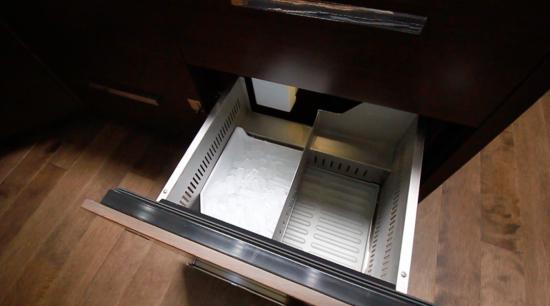
The four refrigerator and freezer drawers can be set to the owner’s specifications. On our test boat, for example, this lower-right drawer was an icemaker freezer.
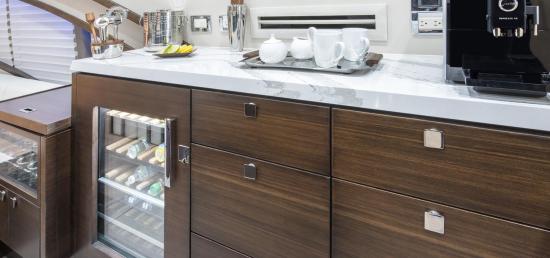
Dining Area
To the port side is the dinette, opposite the helm station, true to this boat’s mission as a family cruising yacht. The dinette is set on an 8” (20.32 cm) elevated platform and seats four in booth-style seating. The table can be either wood or the quartz seen here, and the tableware is included with the boat. An opening side window includes a bug screen.
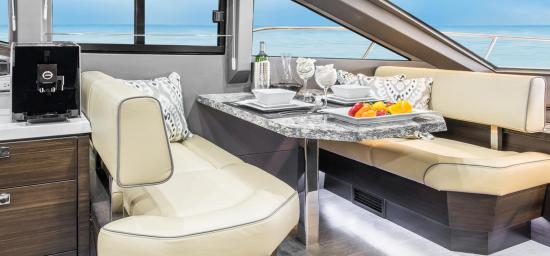
The raised dining booth is cozy and gives everyone a good view.
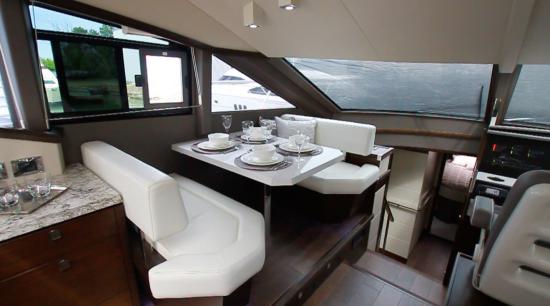
The dinette serves as companion seating to the helm station opposite.
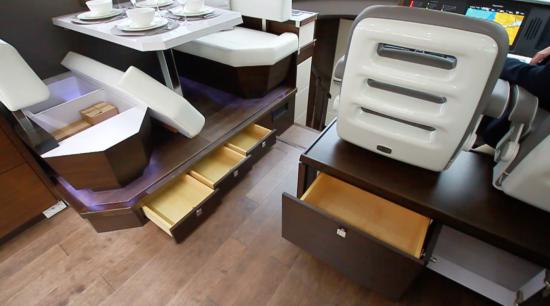
There’s no shortage of stowage in this area, either with drawers beneath the platform and bins beneath the seats as well as drawers and lockers beneath the helm seats.
Helm
The helm dashboard is upholstered in leather and has three horizontal screens in order to monitor virtually everything on the boat. There are two 16” (40.6 cm) Raymarine displays and a center 12” (30.5 cm) display for monitoring the Caterpillar diesels.
Ship’s Systems at a Glance. To the left is an annunciator panel with lights that indicate when a pump comes on and outlines the status of major systems at a glance. One set of indicators shows the status of the ignitions, whether the vanes on the air intake box are open or closed, and whether the genset is running. Another set of indicators pertains to electrical, showing which circuits are active, including the main power, the two 50-Amp shore power cords, the generator, and the 24-volt engine starts.
Still more indicators show the status of the coolant exhaust, the engine room fans, and whether the engine room door is closed. Basically, when underway, the operator wants everything to show green. It’s a traditional setup, simple and easy to understand and take in with one glance.
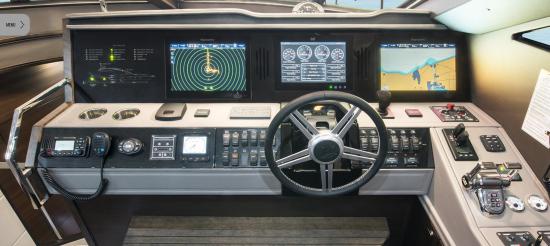
There’s plenty of information to be gleaned from the helm, with two large Raymarine glass-bridge-style displays and a central CAT engine display above the wheel.
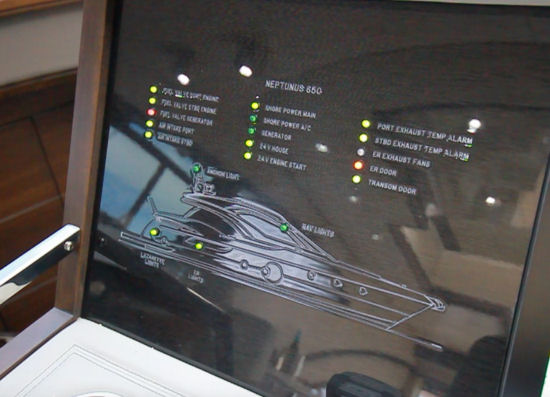
The helm’s line-schematic annunciator panel at the port side gives at-a-glance information about onboard systems.
To starboard is a backup panel since this is a CE category A-Ocean certified vessel. The joystick is to the right of the wheel, and then the bow and stern thruster controls, and the main engine controls are all easy at hand. The helm is set up so that the operator can manage the helm from the seated position.
Alongside the helm seat to starboard is a Simrad AP 70 type-approved offshore autopilot, a VHF, and the remote control for the forward displays.
It’s a helm designed for distance cruising. Sightlines from the helm are outstanding through the large forward windshields with a minimal mullion in the center. Large pantograph wipers have integrated washers, while defoggers blow warm air across the windshield.
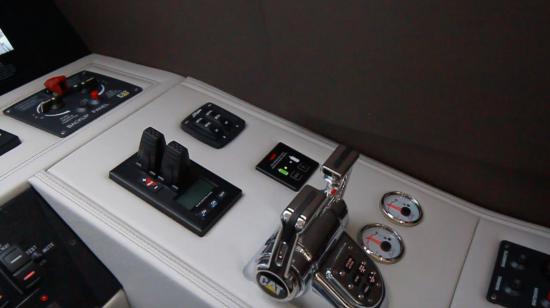
Down the starboard side of the helm are control units that fall easily to the helmsman’s hand.
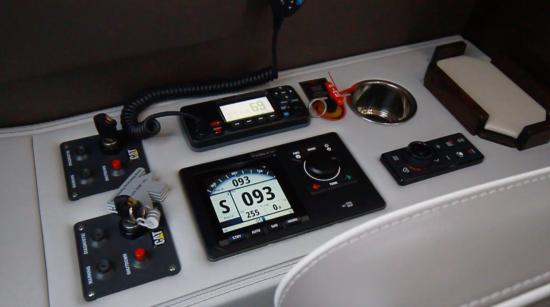
Immediately to starboard of the helm seat are controls to allow the operator to stay comfortable.
Seats
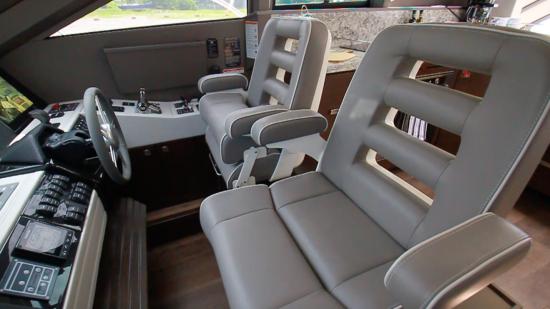
The helm seats adjust position fore and aft and have bolsters.
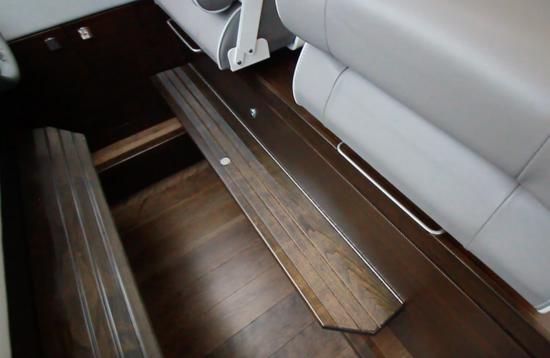
Below the helm seats, there’s a fixed footrest at the bottom of the helm console and a flip-down footrest on the seat base.
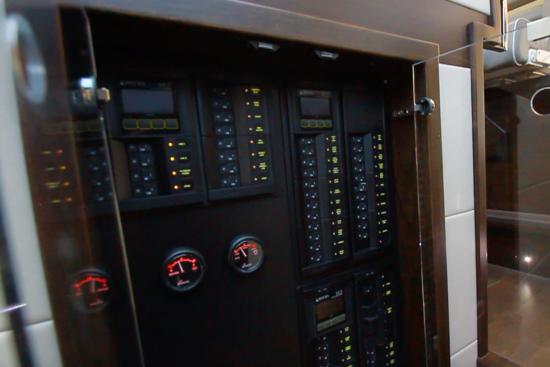
The light-load breaker panel is inside, adjacent to the helm at the companionway leading below.
Accommodations Deck
We access the lower deck through a center companionway, where a convenient grab handle and courtesy lights make it safer to transit the stairs in a range of conditions. We see the same attention to detail, with a single piece of curved cherry wood trim, with a satin finish and contrasting upholstery. This curving shape creates a bit of an atrium beneath the sharply-raked windshield – there’s plenty of natural light. Off the passageway to the master are laundry machines and a locker for stowage.
This is a three-stateroom, three-head layout.
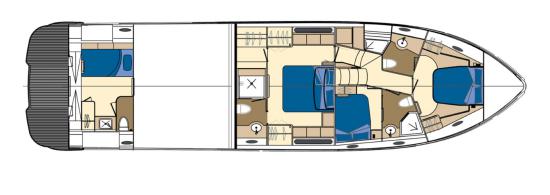
The layout has three staterooms, anchored by the amidships, full-beam master. Note the crew’s quarters aft with wet head.
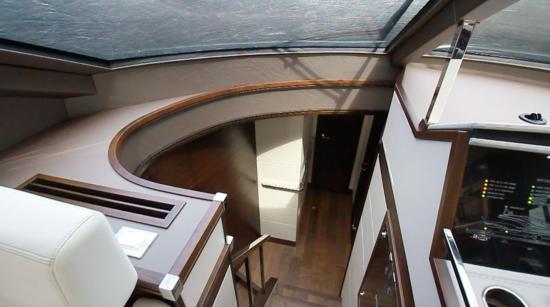
The companionway with its atrium treatment initially may seem a little “over-designed” but the benefits of this curved, enlarged opening become apparent quickly when one notices the natural light it lets shine down the stairs.
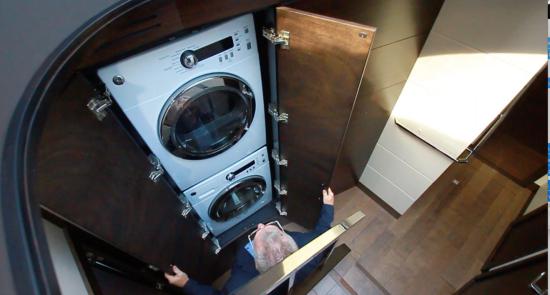
The stacked washer and dryer take advantage of the natural light of the atrium companionway.
Master Stateroom
The master is amidships and takes advantage of the full beam with a king-size berth that measures 6’5” by 6’ (1.96 m x 1.83 m). The berth has a custom headboard made in-house and is mounted ever so slightly to starboard of the centerline.
Headroom is 6’6" (1.98 m) and is 3’4” (1.02 m) at the lowest point over the berth. Hullside windows are to port and starboard, with 12” (30.5 cm) opening portlights just alongside and chests of drawers fabricated from cherry underneath to each side. Cushions are available to sit on top of these cabinets and include angled backs for enjoying the view on a lounge while still keeping the storage.
Stowage. While we usually see cedar-lined hanging lockers to both sides, Neptunus also adds a cedar-lined walk-in closet, making a total of 11 linear feet (3.35 m) of hanging space. Additional stowage under the berth is lighted and has support struts to ease access. The owner’s safe is here as well. There’s still more stowage into the sides. A 40” (102 cm) TV is on the aft bulkhead.
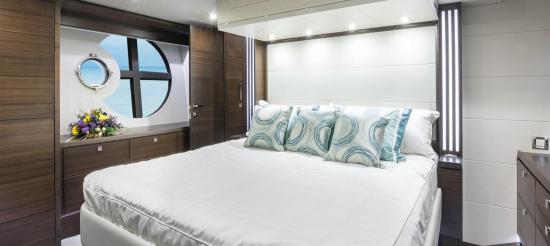
Looking to the port side: The master stateroom has a custom headboard, lots of stowage, a distinctive hullside window, and available cushions to make that chest of drawers into a window seat.
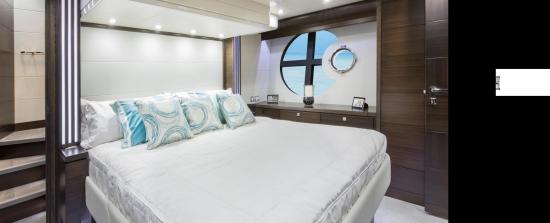
Looking to the starboard side: We see the overhead soffit, the cool illuminated columns flanking the bed, and the classy dark paneling.
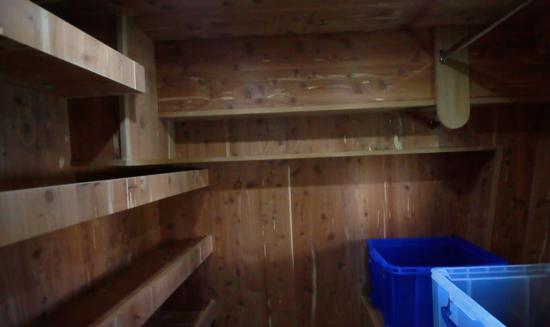
A cedar-lined walk-in locker has the kind of stowage for a serious cruising boat.
A Note on Construction. Since this boat carries a CE Category A-Ocean rating, these side windows are built to meet that spec. Instead of making a mold with openings, this hull is built with aluminum frames extending from the center of the window out to 3’ (0.91 m), and around this opening portlight, making this window frame stronger than the hull itself, and the glass is 1” (2.54 cm) thick.
Master Head
The master head includes a vessel sink atop a quartz counter with an opening portlight just above. The overhead is mirrored, along with the cabinets and a decorative panel above the electric flush head. The sole is tile. A separate walk-in shower has a tiled bulkhead, teak seat, and teak grate decking.
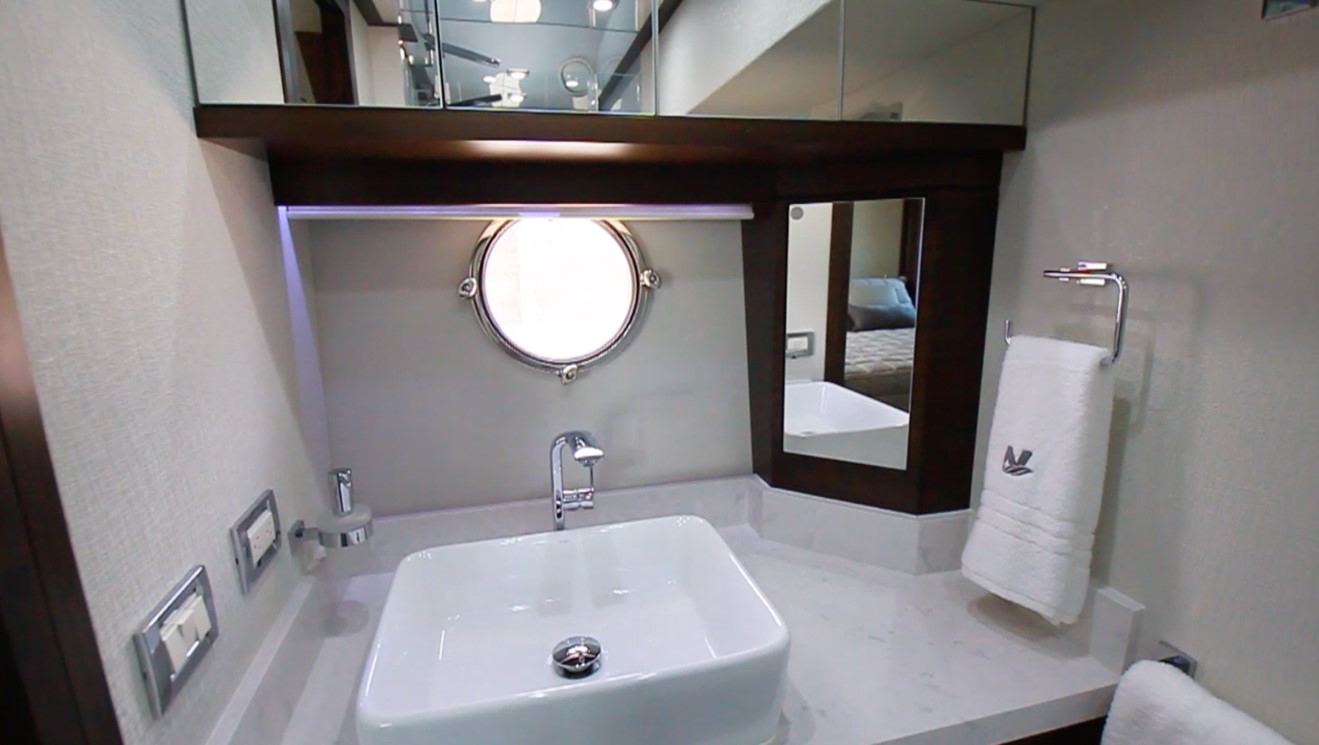
The master head has a basin sink, and mirrors on lockers…
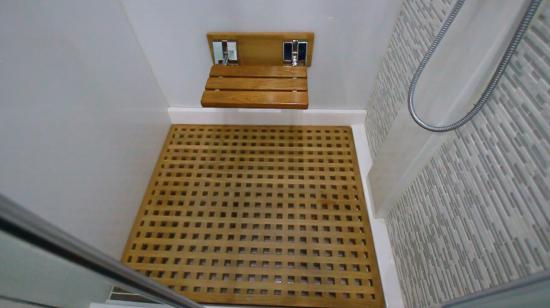
…and a separate walk-in shower with a tiled bulkhead and a teak fold-out seat and deck grate.
Guest Stateroom
The guest stateroom is just to starboard, and it features a double berth with a memory foam mattress and an opening portlight that provides natural light. Cherry cabinetry and a cedar-lined hanging locker supplement the drawer storage under the berth.
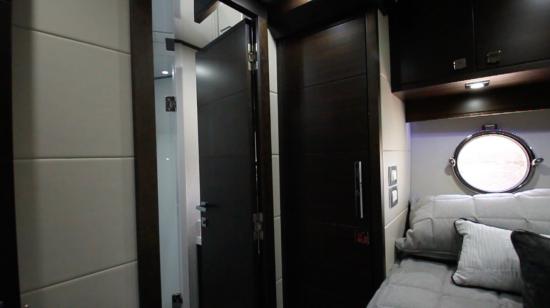
The head is just a step away from the berth and an opening portlight will offer welcome sea air.
Guest Head/Day Head
The guest head is located just forward of the stateroom and it also serves as the day head. It includes a walk-in shower stall.
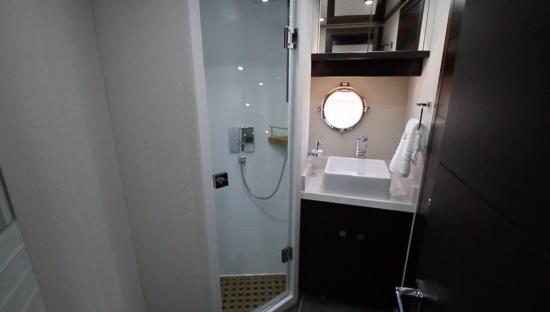
The day head has similar appointments to the master head, but on a smaller scale. Features such as mirrored lockers, a basin sink, and teak shower grate persist.
VIP Stateroom
The VIP stateroom is in the bow, with the typical layout of an island berth with access to both sides, opening portlights, and a custom headboard similar to that in the master suite.
Neptunus has done a good job of using all of the available space for storage, and the port and starboard cabinets in the bow flare add utility and charm. The horizontal accent lights to the left and right of the headboard are a vibration on a theme started in the master and help liven up the space.
The VIP has a private head with the added feature of a skylight in the mirrored ceiling.
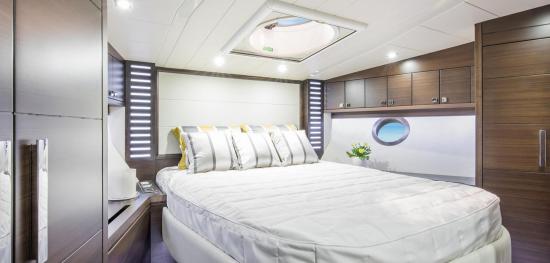
This wide-angle view of the VIP stateroom shows how bright it can be.
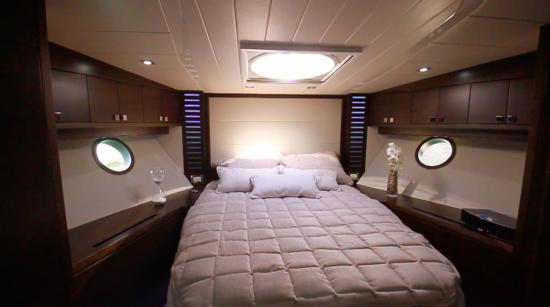
At night the soft lighting in the VIP can make it cozy and, perhaps, romantic.
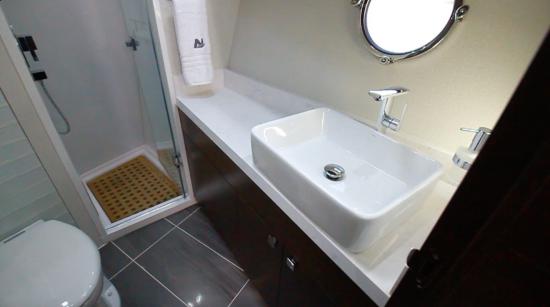
The VIP head is roomy and has a separate shower with glass door.
Side Decks
As we move forward, from the aft deck, we measured the side decks at 17” (43.2 cm) wide and rails come up 33” (84 cm). At the aft end of each side deck is a stainless plate with athwartships slots cut in it for drainage at the waterline instead of streaking the hull.
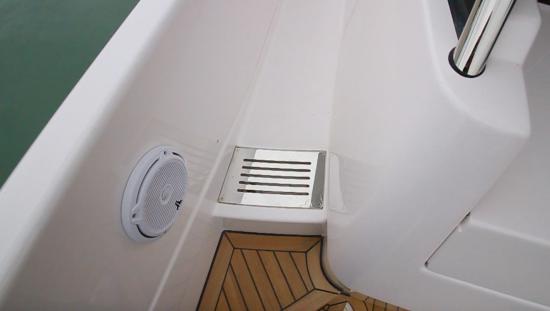
The side deck drain is beneath this polished stainless steel plate.
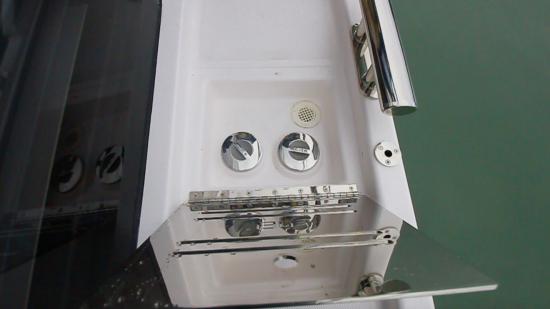
Now here’s a clever feature: Under a stainless cover in the side deck, there are fuel fills to both tanks on both sides of the boat. So, from either side, we can fill either tank.
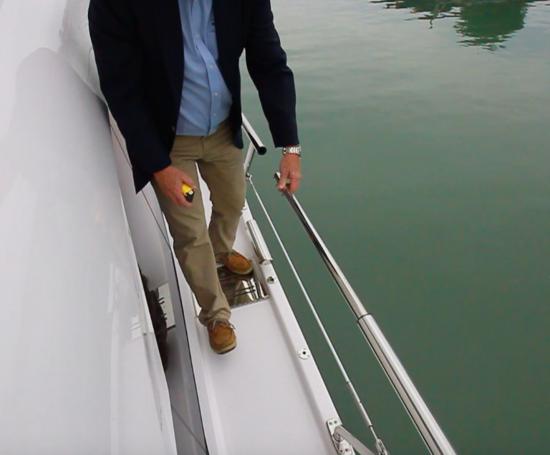
Take a look at this retractable rail, which telescopes forward. It allows for side boarding and a set of Marquipt stairs can fit into the two sockets on the caprail.
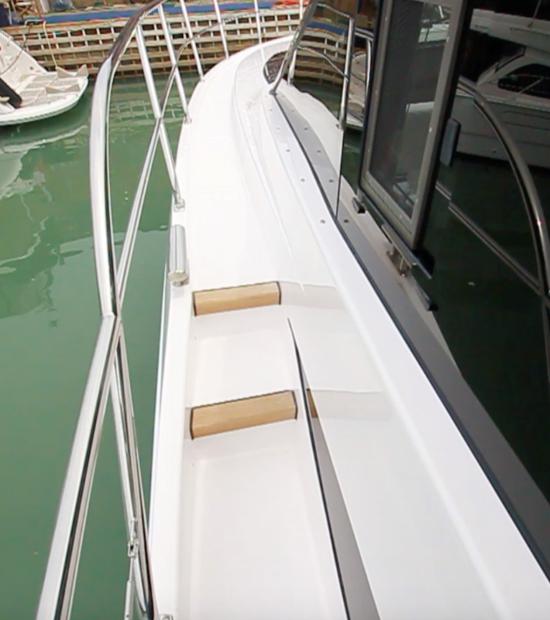
Continuing forward, there are two teak steps 6” (15.24 cm) high with another 13” (33 cm) cleat.
Bow
A doublewide sun pad is forward. The cushions are in fixed positions, but we would like to see adjustable backrests into the chaise lounge position that would have to be only usable at anchor since it would obstruct helm sightlines. The sun pad is surrounded by a rounded stainless railing with integrated beverage holders.
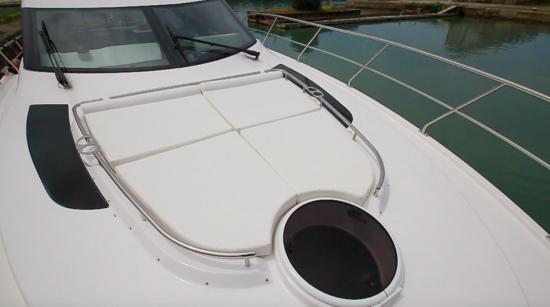
The snaps around the perimeter of the bow sun pad are in an elevated position to let the cover shed water when it is in place.
Ground Tackle
Fully forward at the bow, the ground-tackle system consists of a Maxwell windlass with foot controls just aft. The rode leads through a chain stopper and out a stainless anchor roller. A polished 66 lb. (29.94 kg) plow anchor is ahead.
To the sides, polished stainless chocks lead to chafing strips. Two 13” (33 cm) cleats secure the lines. Further back, two hatches lead to the rode locker, a 170’ (51.82 m) chain rode along with a washdown and hangers for docklines. For safety, the bowrail maintains its 33” (84 cm) height and notice the rugged construction with 1 ½” (3.81 cm) diameter tubing.
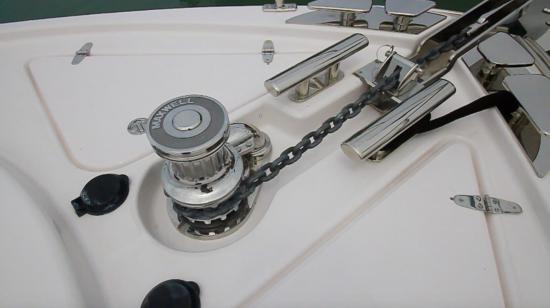
The ground tackle system is thoughtfully designed, right down to tiny LED courtesy lights (visible as a dot just forward of the windlass) in the channel to facilitate safe deployment and recovery in low-light conditions.
Crew’s Quarters
The optional crew’s quarters ($37,250) are aft and access is through the watertight transom door or through the watertight engine-room door. The space is laid out for a crew of one with berth, sink, refrigerator, head, and a TV is mounted to the aft bulkhead. Stowage is beneath the berth, and the boost switches for shore power are convenient to the berth.
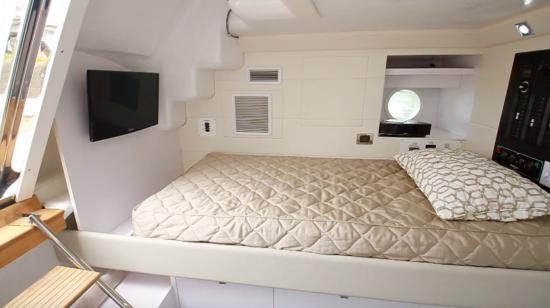
Crew’s quarters aft have a hullside window for natural light.
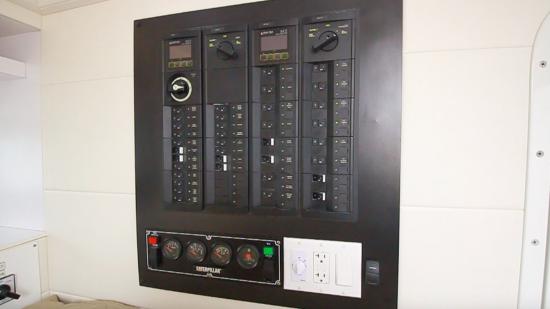
At the head of the berth is the heavy-load electrical panel, with breakers for 24-volt DC, 120-volt AC, and two banks of 240-volt AC, and the generator controls at the bottom.
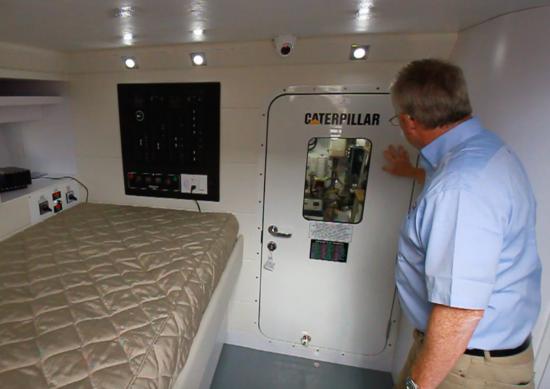
The engine-room door has a tempered-glass window so crew can keep an eye on what’s going on in the mechanical space without opening the door.
Engine Room
The engine room houses the optional twin 1,136-hp Caterpillar C18s ($46,000) in a well-laid-out space with yacht-level qualities, such as 6’4” (1.93 m) headroom. With a 26” wide center walkway between the engines, all service points are accessible from there, including the main engine panel, the raw-water pickups and sea strainers, the oil check, and the filters. We would like to see sea rails surrounding the engines to protect crew in rough conditions.
Storage platforms are over the engines, and everything is well labeled. This is a good use of space. All the thru-hulls in the whole yacht are contained in this watertight space, and each one is double clamped and bonded. The entire compartment is finished in epoxy paint.
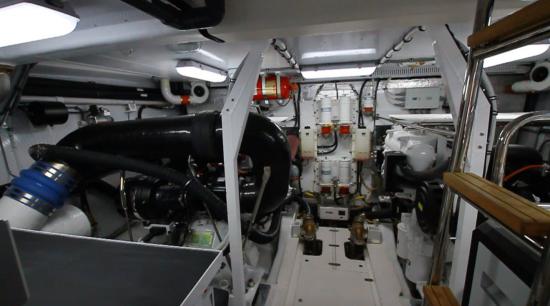
The engine room has headroom of 6’4” (1.93 m).
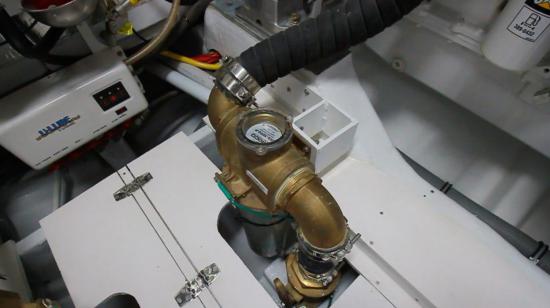
Through-hull fittings are all contained within the watertight engine room and are double-clamped and bonded.
The fuel tank is ahead with dual fuel-water separators for each main and a single for the genset, and rather than have just simple sight tubes, these have spring-loaded valves that we release to view the levels. In that manner, a failure in the tube doesn’t become a fuel spill.
At the aft bulkhead is the single generator (21 kW) with the intake between the two engines’ intakes. Across from the access door is the air chiller system just under a workbench (a yacht-like feature for a mid-60s express cruiser). There’s a hatch in the overhead accessed by a ladder, a second access point to the aft deck so we can enter the engine room when we’re underway in safety.
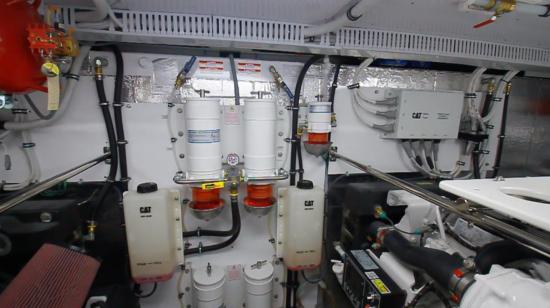
Note the fuel tank at the forward end with duplex Racor fuel-water separators for each engine.
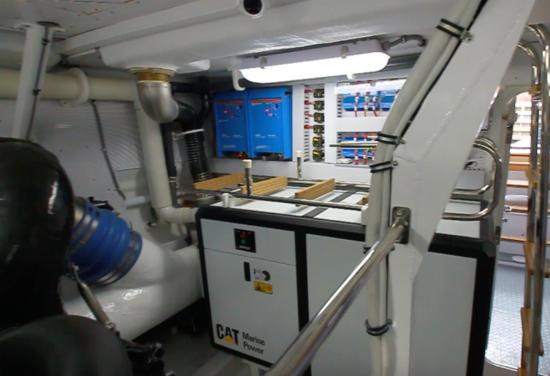
The CAT genset is aft in its hushbox. The generator exhaust is underwater so we’re not aggravating everyone at the mooring field.
Construction
The Neptunus 650 E carries a CE rating of A-Ocean which covers largely self-sufficient boats designed for extended voyages through winds of more than Beaufort Force 8 (speeds over 40 knots), and significant wave heights above 13’ (3.96 m), but excluding abnormal conditions, such as hurricanes.
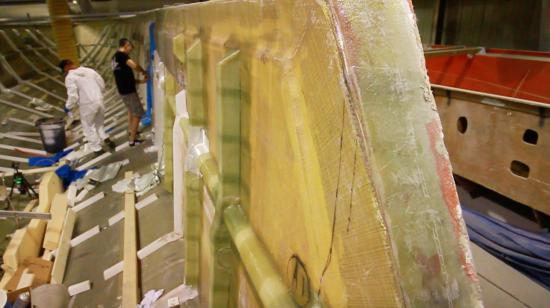
Neptunus builds the strength into the 650 E with Kevlar, the yellow skin seen here, added to both sides of the hull, all the way across from one side to the other. This is highly unusual and we’ve never seen this extensive use of it before. Kevlar is expensive but because it is so strong and does not stretch, it can eliminate the need for some glass in the laminate, which should make the hull lighter as a result.
All of the stringers for the engine mounts are made from Corecell A500 foam (which has a density that amounts to 5 lb. per cubic foot), and they are positioned with laser precision – literally. Neptunus uses Corecell A300 throughout the rest of the yacht. They’re all laid in, literally, with laser precision.
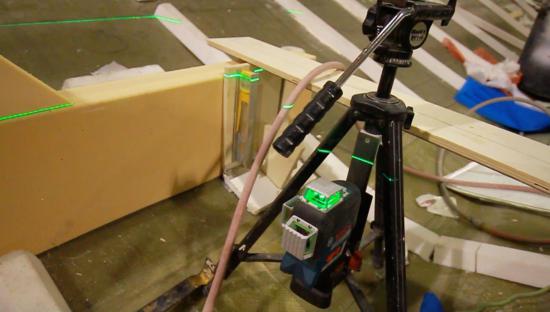
This Bosch laser level helps the layup team position the stringers within the hull precisely.
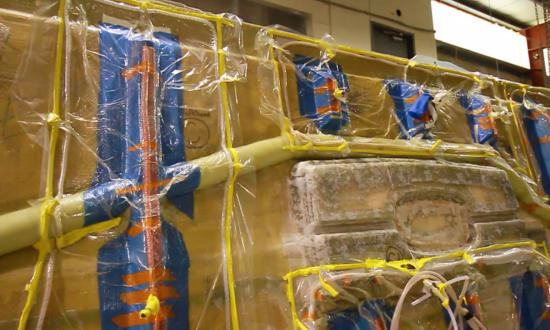
All of the structure is resin infused which saves weight while adding strength. The combination of resin infusion and Kevlar should make the hull extra light and strong. It is also more puncture-resistant.
Water Pump Room
In the passageway sole, there’s a hatch that gives access to an additional mechanical space. This is the water pump room, where we find two water pumps that pressurize the household water system. There are two pumps for built-in redundancy. It’s easy to switch from one pump to the other with the red valves. To the sides, the individual lines are all labeled and can be shut off as desired.
And forward in the same compartment, there is access to the standard bow thruster.
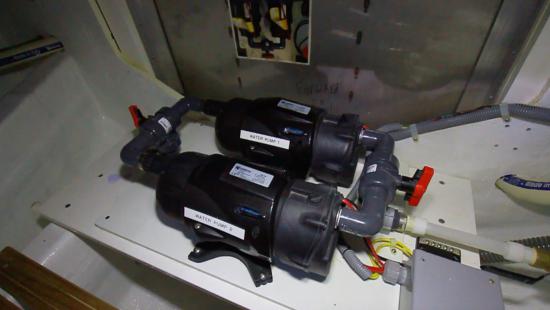
In the water pump room, it’s easy to switch from one pump to the other with the reed valves. Also, note how easy it is to access these pumps, to swap out one that has failed, if needed.
Observations
The Neptunus 650 E has some notable aspects to consider.
- She has a very yacht-like feel and lots of open onboard space.
- Her styling is as sleek as they come
- Her hull is not only resin-infused but also reinforced with Kevlar, and we’re told she carries a CE A rating
- Her fit-and-finish is certainly world-class
- Most everything needed to go cruising is standard
- She has been designed for an owner/operator
We find all of these things compelling. She is built in Canada by a company that started out in the Netherlands 40 years ago but has been on this side of the pond for many years and has built up a small but loyal following. Neptunus builds six models from 55’ to 72’ (16.7 m to 21.9 m).

